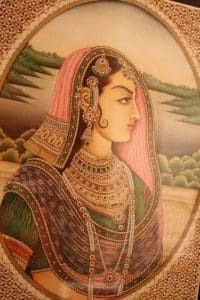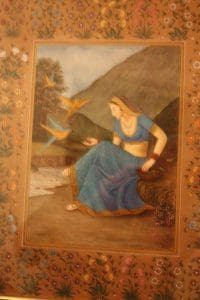
Riot of Colour. by Navneet Parekh.
The Lure of the Indian Miniature: exquisite paintings from Rajasthan shown in London by curator Anita Kapur, By James Brewer
Catch it while you can – the superb artistry of traditional painting in India is little practised these days, a victim of changes in village ways, of helter-skelter urbanisation and of faster means for young people to make money. Even within the arts, a boom in contemporary styles is sadly overshadowing the craft-based work lovingly teased on to the canvas by artists whose skill has been handed down for generations.
No less a figure than Rembrandt recognised the extraordinary character of the Indian miniature when he saw examples in the 1650s, and was moved to copy 25 of them in his own hand. The Dutch called such works “drawings from Surat, ” that being the main Indian seaport before the rise of Mumbai.

A Portrait of a Princess. By Navneet Parekh

Maiden in Blue By Navneet Parekh
While nowadays traditional miniatures are often overlooked in their homeland, there is fortunately a definite market in the UK, United States, Canada and a few other countries for such jewels of creativity, and they are inexpensive by the standards of inflated art world prices.
Playing a huge role in popularising the genre is the curator Anita Kapur from New Delhi who has just hosted her latest event, entitled The Lure of the Miniature, in London. She has been bringing the fine work of miniaturists from Rajasthan to London galleries and private homes for years, and on this occasion offered a total of 45 works from four master miniaturists.

Nathdwara Cows VI By Ghanshyam Nimbuk
The works ache with the delicacy of touch refined by the tradition-loving craftsmen (and a very few women, for the occupation used to be passed down the male line only), and although the term miniature might conjure up a vision of pint-size paintings, it is more descriptive of the brushwork, and many canvases are of a fair, but far from overwhelming, size.
Although they form a select band these days, the artists have distinctive styles and subject matter.

A coy maiden. By Navneet Parekh
Naina Kumari of Jaipur is one of the very few miniaturists who are women, although her family involvement in the field goes way back. She “captures with great sensitivity the romance and opulence of royal India, ” says Anita. A keen sense of excitement is indeed in the air in the output of Naina: she loves celebrations and music, picturing court and gypsy dancers, Hindu princesses and glorious kite festivals.

Guests at private view of The Lure of the Miniature
Ghanshyam Nimbuk is a ‘guru’ to other artists in Jaipur, and for him “painting is a performance just as it must have been in the glorious days of Mughal and Rajput court ateliers, ” according to Anita. Connoisseurs gather in his studio, applauding his skilled brush strokes as if he were a master musician playing a prelude. He manifests his love for animals in representations of the Indian horse. His latest depictions have included some of the thousands of cows kept near a shrine at the Rajasthani town of Nathdwara to provide a daily supply of milk for Lord Shrinathji, one of the forms of Lord Krishna. This prolific artist has painted frescoes for hotels in India.
Navneeth Parekh gave up his career as a civil servant to devote himself to painting. He is attracted to court pageants riotous with colour, and to the stories of Krishna, incorporating in his pictures ivorine, a plastic that has become a substitute for ivory in modern works of art.

Radha & Krishna. By Navneet Parekh

Musicians. By Naina Kumari
All these dexterous artisans follow the practice of centuries by preparing and grinding their pigments from vegetables and minerals. Whites may come from burnt conch shell, black from soot, and vermilions from ground cinnabar mixed with lime juice. A finishing touch of gold leaf or tiny semi-precious stones is often a happy addition. The combinations reflect the history of Jaipur as a staging post for painting, for trading minerals and precious stones, and for making jewellery.
The best artists follow the Mughal tradition of making by hand brushes for the detailed work from fine squirrel hair, each brush to be used for only one pigment.
Anita ensures she has one important piece of equipment handy for viewers: a magnifying glass so that they can appreciate fully the hundreds of brushstrokes that elaborate skin, hair and animal fur. Microscopic inspection reveals that what appears to be solid colour is granulated surface, and simply serves to heighten the allure of these exceptional treasures.
Contact for Anita Kapur is kapur_anita@hotmail.com





